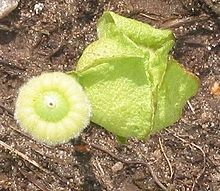Musk mallow
| Musk mallow | ||||||||||||
|---|---|---|---|---|---|---|---|---|---|---|---|---|

Musk mallow ( Malva moschata ) |
||||||||||||
| Systematics | ||||||||||||
|
||||||||||||
| Scientific name | ||||||||||||
| Malva moschata | ||||||||||||
| L. |
The musk mallow ( Malva moschata ) is a species of plant in the subfamily of the Malvoideae within the family of the Malvaceae and is also called Abelmuschus or Indian hibiscus mallow . It is an ancient medicinal plant . It is an example of a neophyte who was consciously introduced by humans several centuries ago.
description
The musk mallow is a perennial herbaceous plant and reaches heights of 20 to 60 centimeters. The upper leaves are divided into five to seven sections down to the bottom, and these in turn into further sections. The individual sections are narrow and the edges are approximately parallel. The lower leaves are only roughly divided in half hand-shaped. In contrast to the rose mallow , the musk mallow has (branched) star hair only on the sepals, the rose mallow also on the upper stem and leaves.
The lateral inflorescences contain one to three flowers. The hermaphroditic flowers, which are said to smell of musk , are radial symmetry and five-fold. The five white to pinkish white petals are usually 2 to 2.5 centimeters long. In the subfamily Malvoideae , the many stamens have grown together to form a tube surrounding the pistil , the so-called Columna .
The number of chromosomes is 2n = 42.
ecology
There is self-pollination or insect pollination. The flowering period extends from June to October.
distribution
The musk mallow is common in Europe. It does not tolerate salt or heavy metals. It colonizes nutrient-rich, not too dry, but also not too moist soils in perennial and perennial weed meadows as well as fresh meadows that are not mowed before the flowering phase. It prefers to grow in lots of direct light. In Central Europe it is a character species of the Arrhenatherion association, but also occurs in societies of the Mesobromion association or the Origanetalia order. In the Allgäu Alps, it rises on the Samstenbergalpe above Balderschwang to an altitude of 1350 meters.
The musk mallow is not protected in Germany and is not subject to any international protection agreements.
More photos
swell
- ↑ Dietmar Aichele: What is blooming there? The photo book. 5th edition. Kosmos, Stuttgart, 2004, ISBN 3-440-10281-5 .
- ^ Silke Lütt: Vegetable new citizens in Schleswig-Holstein: an introduction. In: State Office for Nature and Environment of Schleswig-Holstein (Ed.): Neophytes in Schleswig-Holstein: Problem or Enrichment? Documentation of the conference in the LANU on March 31, 2004 (= publication series of the LANU Schleswig-Holstein, Volume 10). Flintbek 2004, ISBN 3-923339-98-4 , pp. 7–20 (here: p. 8), PDF file .
- ↑ a b Erich Oberdorfer : Plant-sociological excursion flora for Germany and neighboring areas. 8th edition. Verlag Eugen Ulmer, Stuttgart 2001, ISBN 3-8001-3131-5 . Page 658.
- ↑ Eckehart J. Jäger, Klaus Werner (Ed.): Exkursionsflora von Deutschland . Founded by Werner Rothmaler. 10th edited edition. tape 4 : Vascular Plants: Critical Volume . Elsevier, Spektrum Akademischer Verlag, Munich / Heidelberg 2005, ISBN 3-8274-1496-2 .
- ↑ a b Malva moschata L., musk-mallow. In: FloraWeb.de.
- ↑ Erhard Dörr, Wolfgang Lippert : Flora of the Allgäu and its surroundings. Volume 2, IHW, Eching 2004, ISBN 3-930167-61-1 , p. 215.
Web links
- Musk mallow . In: BiolFlor, the database of biological-ecological characteristics of the flora of Germany.
- Profile and distribution map for Bavaria . In: Botanical Information Hub of Bavaria .
- Malva moschata L. In: Info Flora , the national data and information center for Swiss flora .
- Distribution in the northern hemisphere from: Eric Hultén, Magnus Fries: Atlas of North European vascular plants. 1986, ISBN 3-87429-263-0 at Den virtuella floran. (Swedish)
- Thomas Meyer: Data sheet with identification key and photos at Flora-de: Flora von Deutschland (old name of the website: Flowers in Swabia )












